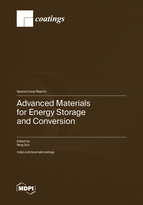Advanced Materials for Energy Storage and Conversion
A special issue of Coatings (ISSN 2079-6412). This special issue belongs to the section "Surface Engineering for Energy Harvesting, Conversion, and Storage".
Deadline for manuscript submissions: closed (20 December 2023) | Viewed by 21443
Special Issue Editor
Interests: carbon and MXene-based materials for energy storage
Special Issues, Collections and Topics in MDPI journals
Special Issue Information
Dear Colleagues,
Energy storage and conversion technologies have risen to the top of the research and industrial interests, given the proportionate growth of renewable energy sources. The extraordinary advancements in energy storage and conversion technologies are inextricably linked to the development of new materials. This Special Issue intends to report on the most recent advances and findings in developing innovative energy storage and conversion technologies, such as lithium/sodium/potassium-ion batteries, lithium-sulfur batteries, supercapacitors, electrocatalysis, and photocatalysis. The contribution of original research articles and reviews on the design, synthesis, theoretical calculation, characterization, characteristics, energy storage mechanism, industrial engineering, and application of various materials for energy storage and conversion are strongly welcomed.
We look forward to receiving your contributions.
Dr. Ning Sun
Guest Editor
Manuscript Submission Information
Manuscripts should be submitted online at www.mdpi.com by registering and logging in to this website. Once you are registered, click here to go to the submission form. Manuscripts can be submitted until the deadline. All submissions that pass pre-check are peer-reviewed. Accepted papers will be published continuously in the journal (as soon as accepted) and will be listed together on the special issue website. Research articles, review articles as well as short communications are invited. For planned papers, a title and short abstract (about 100 words) can be sent to the Editorial Office for announcement on this website.
Submitted manuscripts should not have been published previously, nor be under consideration for publication elsewhere (except conference proceedings papers). All manuscripts are thoroughly refereed through a single-blind peer-review process. A guide for authors and other relevant information for submission of manuscripts is available on the Instructions for Authors page. Coatings is an international peer-reviewed open access monthly journal published by MDPI.
Please visit the Instructions for Authors page before submitting a manuscript. The Article Processing Charge (APC) for publication in this open access journal is 2600 CHF (Swiss Francs). Submitted papers should be well formatted and use good English. Authors may use MDPI's English editing service prior to publication or during author revisions.
Keywords
- advanced material
- inorganic material
- organic material
- nanomaterial
- carbon material
- nanocomposite
- secondary battery
- supercapacitor
- electrocatalysis and photocatalysis






